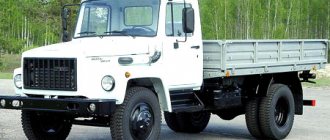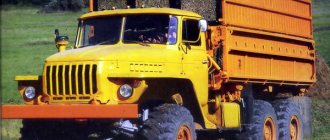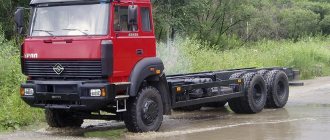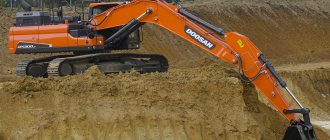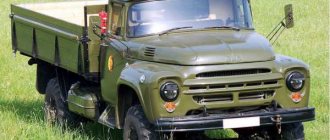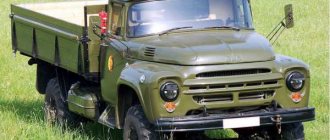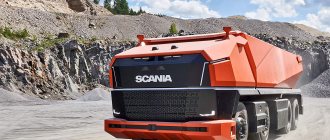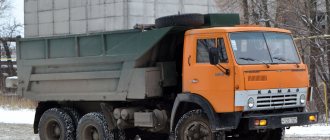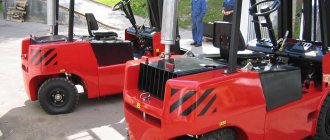SAZ-3503. The car corresponds to the 1979 prototype.
GAZ-93A. The car, made in khaki color, in addition to the company’s stencil, has a red flag on the door with the inscription “Shock Worker of Communist Labor” and a miniature profile of V.I. Lenin
Igor Denisovets, www.denisovets.ru Photo from the archive of Sergei Leontyev and the DIP-models company
On the pages of our magazine we have already talked about the models of SAZ dump trucks produced by the DIP-models company. In June of this year, the latest dump trucks from this company – SAZ-3503 and GAZ-93A – arrived on the shelves of large-scale model stores. However, upon closer examination, it turns out that this is not such a new product. However, first things first.
GAZ-52-04 1977 — DRIVE2
In the fall of 2010, we managed to find a well-preserved copy of the classic Soviet truck GAZ-52-04 for sale.
The car was originally equipped with a booth-installation for disinfecting clothes. The car spent its entire life in army conservation warehouses.
A couple of years ago, the first “civilian” owner bought it from Rosrezerv. He drove the car about 1,000 kilometers - to Gorky and back. In Gorky, the booth was removed from the frame, and an ordinary steel side was installed in its place.
It was with the first owner of the car that I met in the fall. For various reasons, the deal did not take place, and the truck was sold to the second owner, from whom I bought it at the beginning of May 2011.
The body has been removed from the frame and the car is being prepared for a project that will definitely be reported on in a timely manner.
At the moment, sandblasting and powder painting of the wheels, running boards and bumper are being prepared, which, being painted at the metal factory with low-quality black paint, suffered most from the long standing and 4,000 km traveled in the winter of 2010-2011 by the second owner. The cabin will also be completely polished.
In my opinion, like all the creations of Lev Eremeev, the car is incredibly beautiful. The cabin looks advantageous in a discreet “national economic” beige. The sound of a purebred 11th lower-valve six is incomparable!
It fits well with our general disregard for our own history and the fact that not a single one of the many millions of 52nd and 53rd cars has survived to this day in its original form. But it was they who “exported” the entire Soviet economy from the early sixties to the early nineties. I really hope that a bright and calm future awaits this car, in which there will be no place for plebeians at the wheel and impassable swamps under the wheels.
www.drive2.ru
Pleasant authenticity
The GAZ-93A model is made in two color options - the traditional protective green for GAZ (not to be confused with the later khaki!) and sand. The SAZ-3503 received three versions - a blue cab with a sea-green body, a beige cab with a brown body, and a khaki cab with a body of the same brown color. Note that all colors are historically correct - they were all present on the gas conveyor in different years.
Of course, and this is traditional for DIP-models: all models received license plates, including duplicates on the rear side, as well as stencils of motor transport companies applied to the cab doors (except for the sand GAZ-93A).
Well, DIP-models has once again pleased collectors with excellent models, but I don’t intend to stop there. Soon we will be able to purchase models of flatbed trucks GAZ-53F, GAZ-53A and GAZ-53–12, which in addition will have front wheels on bearings, which will allow us to make even more replicas of the front axle and photo-etched mirror pillars (unlike the very thick cast ones on GAZ -52 and models based on it, including SAZ dump trucks).
GAZ-SAZ-3507. Pedigree. Part 3 (GAZ-52-14). — DRIVE2
Part 1 and part 2 here - www.drive2.ru/b/495405305933332931/, www.drive2.ru/b/495726088450736204/
At first, it has nothing to do with the Saransk Dump Truck Plant. My text, that is, Sergei Leontyev. Photos and other pictures from my archive and from around the world.
A beast unknown to science - GAZ-52-14
One of the social networks posted this photo (after all, social networks are a storehouse of useful information).
Full size
4
Signed like this: “1971-1972. Prototype GAZ-52-14. V-shaped six-wheel engine - 116 l/s. 3800 rpm Load capacity 3 tons.” Here is the comment from the person who published this photo: “This photo is from a KEO-GAZ test driver who participated in testing and fine-tuning this car. From his stories, it was a very fast car, with good dynamics and a comfortable car. One significant drawback, in his words, is that he ate AI 93 gasoline. And the photo is from the KEO photo laboratory, N.N. Dobrovolsky. Document number in the lower right corner. I witnessed and saw this car in reality. And I got the photo as a gift and as a souvenir of this car. And the evidence that it is 52-14 is that the sides of the body were lower by one board.” And after some time, he posted another photo of the same car: “Here I found another photo of the GAZ-52-14 from the back. By the way, the rear axle suspension was equipped with shock absorbers.”
Full size
5
In the wonderful book by I. Paderin “GAZ 1932-1982 RUSSIAN CARS” there is a photo of this car, with the same license plate “40-62 PROBA” and a five-board platform side, but with the signature 1973 GAZ-53-11. But it turns out that in this photo there is a GAZ-52-14.
Full size
6
Confirmation of this, after some time, I received at the United Engineering Center LLC GAZ Group, when I saw with my own eyes the registration cards of photographs of this car with the signature GAZ-52-14 and dated 1972.
Full size
7
How do you like the interior of the cabin of a gas truck from the early seventies? I think it's very cute. Separate seats, and the driver's seat is adjustable. Judging by the instrument panels and the two-pointer pressure gauge, the car had pneumatics, or rather a pneumatic-hydraulic brake system. Please note that at this time the Gorky Automobile Plant still continued to produce the GAZ-51...
Full size
8
Part 4 is here - www.drive2.ru/b/496191731625099407/
www.drive2.ru
GAZ-52Ya. History of JSC SAZ. — DRIVE2
GAZ-52Ya. From the series “Products of the Saransk Dump Truck Plant. Unfulfilled..."
(has a direct relationship with the Saransk dump truck plant)
My text, that is, Sergei Leontyev (leontyevsa) based on documents from the archives of JSC SAZ and the Central State Archive of the Republic of Modovia Photos from the same place, and from the archive of I. Paderin
In the old period of the early 60s of the last century, in the “Projects to be designed” section there is information about the GAZ-52Ya car with a lifting tailgate. This car is not mentioned anywhere else. As it turned out later, this is not the only “blank spot” in the history of the production of the Saransk dump truck plant.
“The years of the seventh five-year plan for the newly formed Saransk dump truck plant are the years of its formation and formation as an engineering backwater. During these years, all auxiliary services of the plant were created, the production of new products of special vehicles was mastered and started - MMZ-584B semi-trailers with a lifting capacity of 7 tons for ZIL-164N tractors, dump trucks with preliminary lifting of the SAZ-2500 platform and with three-way unloading of the GAZ-SAZ- platform 53B, produced for the first time in the USSR. The most difficult year was 1961. The facilities of the second stage of the plant, just like the first, were put into operation by the builders with large deficiencies and low quality of construction work. The plant team had to do a lot of finishing work and a lot of remodeling.” This is how he described that period in “A Brief Historical and Economic Essay on the Saransk Dump Truck Plant. 1961-1970." former SAZ employee, direct participant and eyewitness of those events, Inkin Alexander Ivanovich, who headed the economic service of the plant for many years.
However, already at that time the question arose about the future reconstruction of the plant, taking into account the development of the production of new promising products. 1. Dump truck with a platform of increased dimensions with unloading on three sides (analogous to KAZ-602). 2. General purpose van based on the GAZ chassis. 3. Semi-trailers for various purposes: van (analogous to MMZ-776), special for transporting containers (analogous to A-835), dump trucks (analogous to MMZ-811). 4. An onboard vehicle with a hydraulic crane. 5. Flatbed vehicle with a tail lift. It was assumed that vehicle platforms with a hydraulic crane and a tail lift would be manufactured in Saransk. The new enterprise had great prospects for further growth - the plant was to become a leading enterprise in the production of specialized vehicles on the GAZ chassis and semi-trailers. At that time, these plans were not destined to come true, but nevertheless, SAZ returned to these topics years later...
At that time, work was in full swing at GAZ to create a new family of GAZ-52 vehicles, which also included a vehicle with a tail lift. The car was created in accordance with Decree of the Council of Ministers of the USSR No. 936 of August 31, 1960 “On the development of specialized transport” on the basis of the Technical Specifications for the design of a truck with a platform and a lifting tail, approved by the Deputy of the Gorky Economic Council Gorev M.S.
The main purpose of the vehicle was the transportation of containerized cargo, facilitating the process of loading and unloading operations due to their mechanization. The lifting tailgate mechanism of the GAZ-52Ya vehicle is designed for lifting and lowering piece goods or bulk cargo in containers with a base area not exceeding the dimensions of the tailgate and weighing no more than 500 kg.
The board with a load of 500 kg is raised to full height in 10-12 seconds, lowered in 5-8 seconds. As tests have shown, such a vehicle is most effectively used when transporting piece goods weighing 100-150 kg, since heavier loads require greater physical effort to move along the horizontal surface of the platform floor.
Between GAZ and SAZ there was supposed to be a clear division of labor in the development of the GAZ-52YA: the lever lifting mechanism, metal tail lift, hydraulic control crane were designed by KEO GAZ, and SAZ was supposed to develop a power take-off box for the NSh-16V pump. Later, during the production of the sample, the vehicle was in fact equipped with a PTO from a GAZ-93B dump truck and a hydraulic distributor R40/75B.
The topic of the GAZ-52Ya car with a rear lifting side was led by leading designer Ya. M. Zarnitsky from the GAZ design and experimental department, and from SAZ by N. V. Shichalin and Yu. N. Zaichikov. s of the last century, Zaichikov will again have to take up the topic of cars with a cargo bed on the GAZ-33072, GAZ-3302 GAZelle and UAZ-3303 chassis. The rear cargo tailgate was installed on an early example of the GAZ-52 car with the original cab produced no later than 1959. The production time of the sample is not clearly defined; one thing is clear: it was manufactured between the spring of 1961 and July 1962.
On September 17, 1962, the design documentation for the GAZ-52Ya from GAZ was transferred to Saransk, and the SAZ sample itself was going to be picked up later - in November 1962. On September 18, 1961, KEO GAZ employees Ya. M. Zarnitsky and Yu. M. Polev , filed an application for the invention “Mechanism for the lift-up side of a truck,” and in January 1962 they received patent number 151939.
It was assumed that the bead drive mechanism could be easily mounted on a regular GAZ-52 or GAZ-51A truck. To install and fasten it, it was only necessary to have holes in the frame and cutouts in the rear crossbar of the platform base for the passage of levers. The wooden tailgate of the GAZ-52 car is replaced with a metal one, and on the GAZ-51A car the rear transverse beam of the platform base must be additionally strengthened.
www.drive2.ru
Rearranging the places of terms
The developers of DIP-models followed the same path (transplanting bodies onto new chassis). Using the dump body of the previously released GAZ-93B and the excellent GAZ-52 chassis at its disposal, the manufacturer was now able to offer collectors the SAZ-3503 model. And by “mixing” the GAZ-51A chassis and the dump equipment of the already released SAZ-3504, the output was the GAZ-93A model.
It is worth noting that the DIP-models company still floridly designates the car models of the Gorky Automobile Plant not as GAZ, but as “Gorky” - for example, “Gorky 93A”. Apparently, the car plant’s claims against model manufacturers regarding the use of the car’s trade name have not yet been lifted. (Note that if DIP-models simply decided to rename the models to avoid conflict, apparently reasoning that collectors would already understand very well what was being offered to them, then on the GAZ-66 model from SSM, out of harm’s way they even removed the “GAZ” stamping on the front of the model, which did not benefit its replica at all.)
But let's return to the models. Of course, the matter was not limited to just rearranging bodies from model to model. In accordance with the prototypes, the location of the spare wheel mounting brackets has changed - on the left under the dump platform for the SAZ-3503 and vertically behind the cab for the GAZ-93A. As on previous models, the bodies of dump trucks and their rear sides are made to be hinged, and if you turn the models upside down, you will find imitation hoses of the body lifting hydraulic system underneath.
In addition, the GAZ-93A received M-8 tires, which have a smoother road pattern; it seems that DIP-models had not previously used this brand of rubber on their trucks on the GAZ-51A chassis. The engine compartment insulation installed on the sand version of the GAZ-93A received rave reviews from collectors and greatly revitalized the car.
Truck GAZ-52 characteristics photos scale models
GAZ-52 history photos characteristics. Years of manufacture: 1961-1992.
| GAZ-52A | chassis with a wheelbase of 3700 mm for installation of specialized vans. |
| GAZ-52-01 | chassis for buses and specialized vehicles |
| GAZ-52-02 | chassis for SAZ-3503 and SAZ-3504 dump trucks |
| GAZ-52-03 | flatbed, on a long wheelbase chassis, load capacity - 2.5 tons. |
| GAZ-52-04 | basic flatbed truck with a lifting capacity of 2.5 tons |
| GAZ-52-05 | cargo-passenger taxi, equipped with a cargo platform with increased side height and an awning |
| GAZ-52-06 | truck tractor, for working with a 4-ton trailer |
| GAZ-52-07 | based on GAZ-52-04 converted to run on liquefied gas |
| GAZ-52-08 | long-wheelbase chassis based on 52-01, with a gas engine |
| GAZ-52-09 | cargo-passenger taxi converted to run on liquefied gas |
| GAZ-52F | flatbed truck, with prechamber-torch engine, lifting capacity 2.5 tons |
| GAZ-52G | experimental flatbed truck, may be called GAZ-52A, not mass-produced |
| GAZ-52P | experimental truck tractor, not mass-produced |
| GAZ-52Ya | experienced flatbed vehicle, with lifting tailgate |
The end of the 1950s and the mid-1960s were the plans of management at the conveyor plant to produce three generations of trucks, which were unified among themselves. As a base, it was considered to be a brand new GAZ 52
, which became the successor to the GAZ-51A truck, which also had a 4x2 wheel formula and a load capacity of 2.5 tons. When creating
the car
, they tried to take into account that the main area of application of the truck would be urban transportation and operation in rural areas. Taking these points into account, the design features of the car should have ensured good maneuverability and fairly good cross-country ability along with a smooth ride, because asphalt roads were quite rare to find.
photo of GAZ-52
The creation of small and medium-tonnage trucks was necessary for the entire country, since it was undergoing a full-fledged process of restoring the national economy, which was destroyed during wartime, and also required the active construction of residential cities. There were simply very few cars that could operate in the city, and freight transportation as part of a road train did not develop either. Therefore, the design staff was instructed to develop a project for a truck, which was initially intended for transporting various goods in the city and rural areas. There were versions of the GAZ 52 dump truck and on-board vehicle. So, a new model GAZ-52
on the GAZ-51A platform, which has been produced since 1955. A little later, the car was able to successfully replace the previous family. The new car was distinguished by a different cabin, the design solution of which was somewhat similar to American trucks of the 1950s. In those years, many did not even imagine that this design would be in demand during all this time, and this is not much, no less - 30 years.
photo of GAZ-52 truck tractor
Designed all-metal cab
for a small truck, which had a hood layout, was equipped with an improved windshield. Compared to the flat V-shaped windows that were installed on its predecessor, the new one provided the driver with panoramic visibility. The cabin was made for a couple of people. The new cabin was supposed to be unified for all bonneted trucks of the Gorky Automobile Plant, and the external differences were only in a few elements. Moreover, not such a large number of people might know about them, because quite often the GAZ-53 car could be confused with which, by the way, most of the most important components of the car were unified, and the GAZ-52.
photo of GAZ-52
The debut cars of this family were quite similar to the previously produced ZILs - the sidelights were located at the bottom, and the headlights stood strictly above them. When 1975 arrived, the company's management decided to modernize the appearance of the cabin, which is why the sidelights moved upward, and the appearance of the radiator grille began to resemble a “smile”. Nine years later, from 1984, the lining of the radiator grille of GAZ 52 trucks was further changed - its openings were slightly extended, and the turning lamps were moved to the sides. Having a similar appearance, the 52nd models were produced in a conveyor type until the 1990s, after which they were replaced by the restyled GAZ-3307
.
photo of GAZ-52
photo of GAZ-52
Models of the debut years of production had only one single round mirror, located on the left, which was installed on a single bracket. This mount cannot be called reliable, because due to vibrations, it became weak, the mirror began to shift and tremble while driving. A little later it was changed to an oval type, its dimensions increased. They began to install the mirror on the 3rd bracket, which reduced its vibration. They installed something similar on the right side, which increased visibility. The main colors for the cabs were sand and protective khaki. In the 1960s and 1970s, the color options were expanded to include “sea wave” and “cafe au lait.” 1978 allowed the release of cars with a blue cabin color. The same year marked the presence of stamped stiffeners, by which most car enthusiasts could distinguish between the 52nd and 53rd cars. The wheel rims for the pair of cars also differed - the tires for the 52nd model were narrow and had 6 ventilation holes, while the 53rd had 3 holes, and they were located at an angle of 120 degrees. However, despite the slight differences in appearance, the main difference between these cars was the power unit.
Cabin interior
photo salon GAZ-52
It is clear that the cabin was not large, but the most necessary things were there. On two doors, the windows could be lowered and raised, and the windows could be turned. During movement, the air flow could be directed in any direction. Among the features of the cabin, one can highlight the ability to blow hot air from the heater onto the front glass, as well as the ability to install vacuum windshield wipers driven by a special pump. The instrument panel looked quite simple, but for those years, it was quite functional and fulfilled its direct duties. The instrument panel had a fuel level indicator, coolant temperature, oil pressure, speed sensor and ammeter. There was also an ignition switch nearby. Today, dashboards are huge, but the GAZ-52
I received a small but quite informative one. A little to the side there was a place for the glove compartment. The turn switch lever has already been installed on the steering column, which is very convenient, especially considering that on the previous model, the switch was placed on the dashboard, so it was still necessary to reach it, and this caused some difficulties, and the driver could be distracted from driving the truck. However, the entire front panel was made of iron, which also applied to the door panels. There were no separate armchairs, only a full-fledged sofa was provided, the back and seat of which were raised, which provided the opportunity to store various spare parts, parts and tools.
SPECIFICATIONS
Power unit. On cars that were produced between 1958 and 1959, a prechamber-torch engine
internal combustion.
It is this power unit that is considered the advantage of the 51st model. Back in 1937, specialists working at the Institute of Chemical Physics and the Central Institute of Aviation Engine Engineering began to develop and implement options for more productive combustion of gasoline in an internal combustion engine with an external mixture formation system, where there was a lean combustible mixture in the pre-chamber. A little later, this work was already carried out on cars from the Gorky Automobile Plant. The engine platform of the 51st model made it possible to design the GAZ 52 engine
, where the cylinder head was modernized and where there was an overhead valve arrangement. In addition, the cylinder head was equipped with a prechamber for each cylinder. The gas distribution system had a chamber valve through which an air-combustible mixture was injected, which was lit by an ordinary candle. After this, the torch ignites the entire mixture in the main chamber. This technical process allowed saving up to 20% of fuel, as they believed then.
photo GAZ-52 engine
It also seemed that in this way it would be possible to significantly increase the power of the power unit along with torque. But as tests showed, the GAZ 52 engine was difficult to start, it was also impossible to save fuel, and in general, the unit functioned unstably. Moreover, problems were created by the carburetor, which even at the enterprise itself, even competent specialists, were almost unable to somehow regulate or configure. However, such failures did not stop the specialists, and they still brought the power unit to the desired state. As a result, a 3.4-liter 85-horsepower engine was produced, which had a torque at 3,000 rpm - 22.5 kg/m. This GAZ 52 engine made it possible to significantly increase the dynamic component and make the car more economical. For 100 kilometers, the GAZ-52 eats about 24 liters. Years later, in the 1990s, motorists noticed trucks that ran on diesel fuel. Quite a few drivers began installing brand new GAZ 52 diesel engines
, which were notable for their low maintenance costs.
TRANSMISSION
Transmission. The new power unit has been synchronized with a reliable and quiet five-speed manual gearbox. She had synchronizers in 3rd and 4th gear. The clutch is single-disc and dry. Example photo below.
Suspension
.
They decided to install it as a spring type, and later it was subject to modernization. The design staff decided to change the method of fastening the springs - after improvement, the fastening was carried out together with rubber cushions. As a result, it was possible to reduce the pressure on the main sheets while twisting the springs. The front suspension was on longitudinal semi-elliptical springs along with hydraulic telescopic shock absorbers. The rear suspension had only longitudinal semi-elliptical springs with additional springs. Both front and rear were equipped with dependent suspension. And in order to increase the cross-country ability of trucks on bad roads, the engineering staff developed and implemented the latest rear axles, which had a cam differential. This made it possible to more confidently pass difficult areas of the road. Brake system
.
It has a hydraulic drive and a hydraulic vacuum booster. Only drum brakes are used on all wheels. There is a working and parking system. Steering
. The steering mechanism is of the globoid type. Globoid worm together with a double-ridge roller. There is no hydraulic power steering.
GAZ-52 photos
photo of GAZ-5204
photo of GAZ-5206
photo of GAZ-5202 dump truck
photo of GAZ-52Ya
photo of GAZ-52Ya
photo GAZ-52 Fire escape
photo GAZ-52 Fire tank
dar-web.ru
